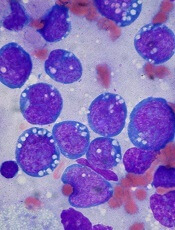
Image by Ed Uthman
Preclinical research suggests a novel class of compounds are effective against pediatric and adult cancers, including lymphoma.
The compounds are amphiphilic amines (RCn) based on a tricyclic amine hydrophilic head and a hydrophobic linear alkyl tail of variable length.
The RCn compounds proved cytotoxic in a range of cancer cell lines, including the Burkitt lymphoma cell line Ramos.
The lead compound, RC16, exhibited antitumor effects in vivo and enhanced the in vitro activity of 3 other anticancer agents.
Timothy Cripe, MD, PhD, of Nationwide Children’s Hospital in Columbus, Ohio, and his colleagues reported these results in Pharmaceutical Research.
The investigators first evaluated the RCn compounds for cytotoxicity and mechanism of cell death in several adult and pediatric cancer cell lines.
“We tested RCn’s tumor killing efficacy in cell lines of numerous cancers, including sarcomas, lymphoma, and neuroblastoma,” Dr Cripe said. “We observed anticancer activity of the RCn amines in all the cancer cell lines analyzed.”
The investigators also found that RC16 was 10 times more effective in harming tumor cells than normal cells, including keratinocytes, fibroblasts, and umbilical vein endothelial cells.
In addition, RC16 demonstrated “significant antitumor effects” in several mouse models of malignancy, both when given intravenously and orally.
Because of the amphiphilic molecular structure of RC16, it self-assembled into micelles in water. This chemical structure allowed complexation of the anticancer drugs doxorubicin, etoposide, and paclitaxel.
The micelles significantly improved the in vitro antitumor activity of these drugs by enhancing their solubility in water.
“The antitumor activity of lipophilic amines was interesting because of its action on the mitochondria and lysosomes of cells,” said study author Isabella Orienti, PhD, of the University of Bologna in Italy.
“Moreover, their amphiphilic character improves their bioavailability. We correctly hypothesized these amphiphilic amines would have high antitumor activity and high bioavailability.”
“We are in the process of determining our next steps with testing this new drug,” Dr Cripe added. “This is a promising new therapy for adult and pediatric cancers, and we look forward to further testing its merits.”


